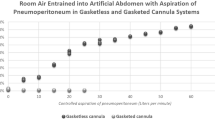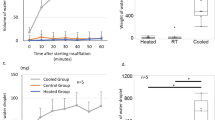Abstract
Background: Recently, several animal studies showed that the core body temperature falls during pneumoperitoneum, and this hypothermia could be prevented by using heated and humidified gas insufflation. However, there are no satisfactory heated humidifiers to meet this purpose. Therefore, we developed a new membrane-type heated humidifier. Materials and methods: The newly developed heated humidifier employs an ion-exchange membrane (Nafion: Du Pont Co. Ltd) tube that passes water selectively in molecular form and a gas compartment is completely separated from distilled water to prevent infection. This humidifier consists of a Nafion tube assembly and a case that includes the heater. A perforated protecting tube is located outside the Nafion tube to prevent direct contact with the Nafion tube when it is assembled. The Nafion tube assembly is inserted in the case, and dry gas flows inside of the Nafion tube. The space between the case and the Nafion tube assembly is filled with distilled water. A heater raises the temperature of the distilled water, and heat and water vapor are transferred to cold and dry gas through the Nafion membrane. Four different types of insufflators were involved in this performance comparison study: a Nafion-based heated and humidified insufflator, a conventional heated insufflator, a conventional heated and humidified insufflator, and a conventional cold and dry insufflator. Temperature and relative humidity were measured once each minute for 15 min, which was repeated four times. Each insufflator was operated at two rates of flow: 5 L/min and 10 L/min. Results: Temperature and humidity of the conventional cold and dry insufflator, the Nafion membrane-type heated and humidified insufflator, the conventional heated insufflator, and the conventional heated and humidified insufflator measured at the distal end of circuit reached 22.0 ± 0.2°C and 0%, 36.7 ± 1.1°C and 100%, 29.0 ± 0.4°C and 0%, and 31.3 ± 0.4°C and 70.5 ± 5.3% in 15 min at 5 L/min flow rates. At 10 L/min flow rates, temperature and humidity were almost the same as those at 5 L/min. The membrane-type heated humidifier demonstrated statistically significant improvement in both the temperature (p < 0.0001) and relative humidity (p < 0.0001) parameters in comparison to the conventional normal, heated, or heated and humidified insufflators at 5 L/min and 10 L/min continuous flow rate in statistics using repeated-measure ANOVA. Conclusion: This newly developed heated humidifier offers the great advantages of maintaining intraabdominal temperature and humidity in comparison to conventional insufflators for laparoscopic surgery.








Similar content being viewed by others
References
E Berber A String A Garland KL Engle KM Kim P Ituarte AE Siperstein (2001) ArticleTitleIntraoperative thermal regulation in patients undergoing laparoscopic vs open surgical procedures. Surg Endosc 15 281–285 Occurrence Handle1:STN:280:DC%2BD38%2FgvFyjug%3D%3D Occurrence Handle11344429
JR Bessell A Karatassas JR Patterson GG Jamieson GJ Maddern (1995) ArticleTitleHypothermia induced by laparoscopic insufflation: A randomized study in a pig model. Surg Endosc 9 791–796 Occurrence Handle1:STN:280:BymD3MvjsFw%3D Occurrence Handle7482186
JR Bessell G Ludbrook SH Millard PS Baxter SS Ubhi GJ Maddern (1999) ArticleTitleHumidified gas prevents hypothermia induced by laparoscopic insufflation: A randomized controlled study in a pig model. Surg Endosc 13 101–105 Occurrence Handle10.1007/s004649900914 Occurrence Handle1:STN:280:DyaK1M7hslCksg%3D%3D Occurrence Handle9918606
TR Huntington CB LeMaster (1997) ArticleTitleLaparoscopic hypothermia: Heat loss from insufflation gas flow. Surg Laparosco Endosc 7 153–155 Occurrence Handle10.1097/00019509-199704000-00018 Occurrence Handle1:STN:280:ByiB28zgsVQ%3D
PR Koninckx E Vandermeersch (1991) ArticleTitleThe persufflator: an insufflation device for laparoscopy and especially for CO2-laser-endoscopic surgery. Hum Reprod 6 1288–1290 Occurrence Handle1:STN:280:By2D1M7kslc%3D Occurrence Handle1836468
Madedern G (1996) Hypothermia during laparoscopic operation is a serious but preventable complication. 5th World Congress of Endoscopic Surgeons, Postgraduate Course, pp 13–20
B Mansvelt P Arnould C Bertrand A de Neve de Roden (1995) ArticleTitleUtilization of gas heater humidifier in the course of coelioscopies. Acta Chir Belg 95 100–102 Occurrence Handle1:STN:280:ByqB2svjsVY%3D Occurrence Handle7754729
J Monagle P Wongprasartsuk W Shearer (1993) ArticleTitleCarbon dioxide, temperature and laparoscopic cholecystectomy. Aust NZ J Obstet Gynaecol 33 430–432 Occurrence Handle1:STN:280:ByuB3svpslY%3D
WG Mouton JR Bessell SH Millard PS Baxter GJ Maddern (1999) ArticleTitleA randomized controlled trial assessing the benefit of humidified insufflation gas during laparoscopic surgery. Surg Endosc 13 106–l08 Occurrence Handle10.1007/s004649900915 Occurrence Handle1:STN:280:DyaK1M7hslCksw%3D%3D Occurrence Handle9918607
DE Ott (1991) ArticleTitleLaparoscopic hypothermia. J Laparoendosc Surg 1 127–131 Occurrence Handle1:STN:280:By2D1cbms1w%3D Occurrence Handle1836397
DE Ott (1991) ArticleTitleCorrection of laparoscopic insufflation hypothermia. J Laparoendosc Surg 1 183–186 Occurrence Handle1:STN:280:By2D3szitV0%3D Occurrence Handle1834266
MI Puttik DM Scott-Coombes J Dye CC Nduka NM Menzies-Gow AO Mansfield A Darzi (1999) ArticleTitleComparison of immunologic and physiologic effects of CO2 pneumoperitoneum at room and body temperatures. Surg Endosc 13 572–575 Occurrence Handle10.1007/s004649901043 Occurrence Handle10347293
K Semm WD Arp M Trappe D Kube (1994) ArticleTitlePain reduction after pelvi/-laparoscopic interventions by insufflation of CO2 gas at body temperature (Flow-Therme). Geburtshilfe Frauenheilkd 54 300–304 Occurrence Handle1:STN:280:ByuA38jgsFA%3D Occurrence Handle8050692
CW Sheffield DI Sessler TK Hunt (1994) ArticleTitleMild hypothermia during isofluorane anesthesia decreases resistance to E. coli dermal infection in guiea pigs. Anesth Analg 38 201–205 Occurrence Handle1:STN:280:ByuB1Mrjs1I%3D
Author information
Authors and Affiliations
Corresponding author
Rights and permissions
About this article
Cite this article
Matsuda, M., Sekikawa, T., Onodera, K. et al. Development of a new membrane-type heated humidifier for laparoscopic surgery . Surg Endosc 17, 1144–1150 (2003). https://doi.org/10.1007/s00464-002-8602-7
Received:
Accepted:
Published:
Issue Date:
DOI: https://doi.org/10.1007/s00464-002-8602-7




